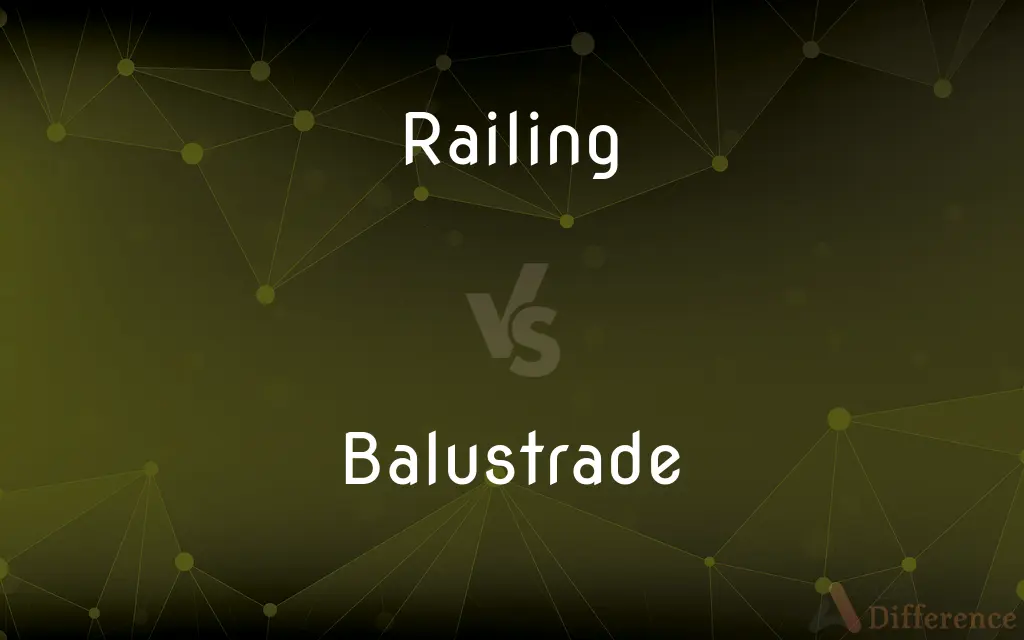Railing vs. Balustrade — What's the Difference?
By Tayyaba Rehman & Fiza Rafique — Updated on March 13, 2024
Railings are protective barriers installed along edges of stairs, balconies, or decks, while balustrades are a series of posts (balusters) topped by a rail, serving as a decorative and supportive feature.

Difference Between Railing and Balustrade
Table of Contents
ADVERTISEMENT
Key Differences
Railings are safety features designed to prevent falls from elevated surfaces such as stairs, balconies, and decks. They can be made from a variety of materials, including wood, metal, glass, or composite materials, and serve the primary function of providing support and preventing accidents. On the other hand, a balustrade is a more specific type of railing system that consists of a series of balusters—vertical posts—supporting a top rail. Balustrades are often used for their decorative appearance as well as their functional purpose of providing safety and support.
While railings might consist of a single bar or a simple structure to serve as a guard or support, balustrades are characterized by their repetitive posts (balusters) which can be styled in numerous designs, making them an architectural feature in addition to a safety mechanism. Balustrades are commonly found in classical and modern architecture, adding aesthetic value to staircases, balconies, and terraces.
The term "railing" is used more broadly and can refer to any barrier or fencing used for safety or delineation purposes, not necessarily limited to elevated surfaces. Balustrades, however, are specifically part of a railing system with a distinctive architectural element—the balusters—which are designed and spaced according to building codes to prevent accidents.
In practical terms, the choice between a railing and a balustrade often comes down to the intended use, desired aesthetic, and budget. Railings can be simple and functional for safety, while balustrades offer an opportunity to incorporate design elements into a building’s architecture. However, it’s important to note that all balustrades are railings, but not all railings qualify as balustrades due to the specific structural and design requirements of balustrades.
While both railings and balustrades serve the important function of safety, balustrades are particularly noted for their potential to enhance the architectural style of a space. Whether choosing a railing or a balustrade, compliance with local building codes and regulations is essential to ensure the safety and integrity of the structure.
ADVERTISEMENT
Comparison Chart
Definition
A barrier for safety, installed along edges of stairs, balconies, or decks.
A series of balusters supporting a rail, used as a decorative and protective barrier.
Components
Can be a single bar or a structure of supports.
Consists of balusters (posts) and a top rail.
Function
Provides support and prevents falls.
Serves both a decorative and safety function.
Use
Broader use in various settings for safety.
Architecturally decorative, used in stairs, balconies, and terraces.
Material
Wood, metal, glass, composite.
Often made from wood, stone, metal, or composite materials.
Aesthetic
Can range from simple to complex.
Often designed with intricate details for aesthetic appeal.
Design Element
Primarily functional.
Both functional and highly decorative.
Architectural Use
Common in various types of buildings for safety.
Used to enhance architectural style and beauty.
Compare with Definitions
Railing
A safety barrier along staircases.
The wooden railing was polished to a shine.
Balustrade
Architectural feature with balusters.
The marble balustrade bordered the grand staircase.
Railing
Simple or complex designs.
The glass railing offered an unobstructed view.
Balustrade
Enhances aesthetic appeal.
The intricately carved balustrade was a focal point.
Railing
Prevents falls and accidents.
The railing on the bridge ensures pedestrian safety.
Balustrade
Offers support and safety.
The balustrade provided a secure barrier on the terrace.
Railing
Guard for balconies or decks.
The steel railing encircles the entire deck.
Balustrade
Reflects design and style.
The modern balustrade added to the building's sleek look.
Railing
Versatile in material and use.
The composite railing requires little maintenance.
Balustrade
Component of classical architecture.
The balcony featured a Renaissance-style balustrade.
Railing
A fence or barrier made of rails
Wrought-iron railings
Balustrade
A railing supported by balusters, especially one forming an ornamental parapet to a balcony, bridge, or terrace.
Railing
A structure made of a rail, often connecting a series of upright members, that is used as a guard or barrier or for support, as on a balcony or next to a staircase.
Balustrade
A rail and the row of balusters or posts that support it, as along the front of a gallery.
Railing
The rail of such a structure.
Balustrade
A row of balusters topped by a rail, serving as an open parapet, as along the edge of a balcony, terrace, bridge, staircase, or the eaves of a building.
Railing
Rails considered as a group.
Balustrade
A row of balusters topped by a rail, serving as an open parapet, as along the edge of a balcony, terrace, bridge, or the eaves of a building, or as a guard railing on a staircase; - it serves as a guard to prevent people from falling.
Railing
A fence or barrier consisting of one or more horizontal rails and vertical supports.
During the war, everyone's railings were taken away to make bombers.
Balustrade
A railing at the side of a staircase or balcony to prevent people from falling
Railing
Present participle of rail
Railing
Expressing reproach; insulting.
Angels, which are greater in power and might, bring not railing accusation against them.
Railing
A barrier made of a rail or of rails, together with vertical supports. The typical railing in the interior of structures or on porches has a horizontal rail near waist height, and multiple vertical supports. Its function is usually to provide a safety barrier at the edge of a verticle drop to prevent falls.
Railing
Rails in general; also, material for making rails.
Railing
A barrier consisting of a horizontal bar and supports
Railing
Material for making rails or rails collectively
Common Curiosities
Are balustrades more expensive than simple railings?
Balustrades can be more expensive due to their decorative elements and the materials used.
What is the primary function of a railing?
The primary function of a railing is to provide safety and prevent falls from elevated surfaces.
How does a balustrade differ from a simple railing?
A balustrade differs in that it includes a series of balusters supporting a top rail, serving both a decorative and safety function.
What role do balustrades play in architectural design?
Balustrades play a significant role in architectural design by adding aesthetic value and character to buildings and structures.
How do building codes affect railing and balustrade designs?
Building codes specify requirements for height, strength, and spacing to ensure safety, affecting both railing and balustrade designs.
What materials are commonly used for balustrades?
Common materials for balustrades include wood, stone, metal, and composite materials.
How should one choose between a railing and a balustrade for a project?
The choice should be based on the project's safety requirements, aesthetic goals, and budget, considering both the functional and decorative aspects.
Can any railing be considered a balustrade?
Not all railings are balustrades; only those with a specific structure of balusters supporting a rail qualify as balustrades.
Can balustrades be used indoors?
Yes, balustrades are often used indoors as part of staircases and landings, adding to the interior decor.
Is it possible to retrofit an existing railing into a balustrade?
It is possible to retrofit, depending on the structure; however, it may require significant modifications to meet the design and safety standards of a balustrade.
Share Your Discovery

Previous Comparison
Ironsmith vs. Blacksmith
Next Comparison
Realization vs. RecognitionAuthor Spotlight
Written by
Tayyaba RehmanTayyaba Rehman is a distinguished writer, currently serving as a primary contributor to askdifference.com. As a researcher in semantics and etymology, Tayyaba's passion for the complexity of languages and their distinctions has found a perfect home on the platform. Tayyaba delves into the intricacies of language, distinguishing between commonly confused words and phrases, thereby providing clarity for readers worldwide.
Co-written by
Fiza RafiqueFiza Rafique is a skilled content writer at AskDifference.com, where she meticulously refines and enhances written pieces. Drawing from her vast editorial expertise, Fiza ensures clarity, accuracy, and precision in every article. Passionate about language, she continually seeks to elevate the quality of content for readers worldwide.














































